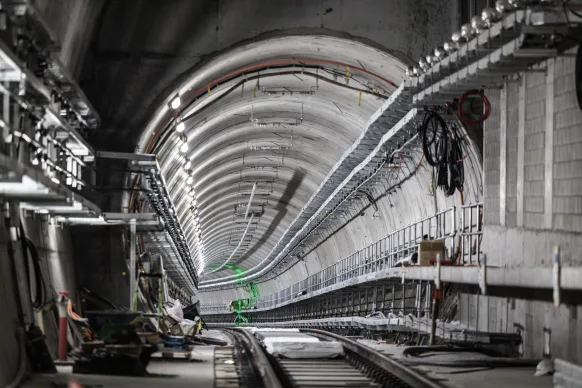Erros comuns na instalação de tubos de conduíte de PVC e como evitá-los
Quando se trata de fiação elétrica, a instalação adequada de conduítes é crucial para a segurança e a longevidade. Embora possa parecer um processo simples, mesmo pequenos erros podem causar grandes problemas no futuro. Nesta publicação, abordaremos alguns erros comuns na instalação de tubos de conduítes de PVC e como evitá-los.
Erros comuns na instalação de tubos de conduíte de PVC
- Usando o tipo errado de conduíte: Nem todos os tubos de conduíte de PVC são criados iguais. Dependendo da localização, ambiente e propósito da sua instalação, você pode precisar escolher um tipo específico de conduíte. Por exemplo, se seu conduíte for exposto à luz solar ou altas temperaturas, você vai querer usar um conduíte resistente a UV ou de alta temperatura.
- Fixação inadequada do conduíte: tubos de conduíte de PVC precisam ser fixados adequadamente para evitar flacidez ou deslocamento ao longo do tempo. Não usar suportes ou cintas suficientes pode fazer com que o conduíte dobre ou até mesmo caia da parede, causando danos ao cabo ou fluxo de ar restrito.
- Sem levar em conta a expansão e a contração: tubos de conduíte de PVC podem expandir e contrair com mudanças de temperatura. Se você não deixar espaço suficiente ou usar os suportes adequados, seu conduíte pode entortar ou rachar com o tempo.
- Usar muitas curvas: embora os tubos de conduíte de PVC sejam flexíveis e fáceis de dobrar, a curvatura excessiva pode causar torções ou bloqueios que impedem a passagem do cabo. Usar muitas curvas também pode colocar estresse desnecessário no conduíte e torná-lo mais propenso a rachar ou quebrar.
- Não colar as juntas corretamente: Ao unir tubos de conduíte de PVC, é importante usar primer e cimento para criar uma vedação forte e à prova de vazamentos. Não fazer isso pode resultar em separação ou vazamentos, o que pode levar a danos causados pela água, choque elétrico ou até mesmo incêndio.
As consequências dos erros de instalação de tubos de conduíte de PVC
Cada um dos erros listados acima pode ter consequências sérias se não for abordado. Aqui estão alguns problemas potenciais que você pode encontrar:
- Corrosão e degradação: Usar o tipo errado de conduíte ou não colar as juntas pode levar à corrosão, degradação ou até mesmo derretimento ao longo do tempo. Isso pode comprometer a integridade da sua instalação e colocar seus cabos em risco.
- Flacidez ou deslocamento: um conduíte mal fixado pode flacidez ou deslocamento ao longo do tempo, o que pode causar danos ao cabo ou restrição ao fluxo de ar.
- Rachaduras ou quebras: se você não levar em conta a expansão e a contração ou usar muitas curvas, seus tubos de PVC podem rachar ou quebrar, resultando em reparos caros.
- Fluxo de ar restrito ou danos no cabo: Dobrar ou bloquear excessivamente pode restringir o fluxo de ar e causar acúmulo de calor, o que pode danificar os cabos e criar risco de incêndio.
- Vazamentos ou separação: Não colar as juntas corretamente pode resultar em vazamentos ou separação, o que pode causar danos causados pela água ou choque elétrico.
Como evitar erros comuns na instalação de tubos de conduíte de PVC
Felizmente, a maioria dos erros de instalação de tubos de conduíte de PVC podem ser evitados com planejamento e execução adequados. Aqui estão algumas dicas para fazer isso direito:
- Escolha o tipo certo de conduíte: leve em consideração a localização, o ambiente e a finalidade da sua instalação e escolha um tubo de conduíte de PVC que atenda às suas necessidades.
- Fixe o conduíte corretamente: use suportes ou cintas suficientes para evitar que ele fique flácido ou se mova com o tempo.
- Permita a expansão e a contração: deixe espaço suficiente e use os suportes adequados para compensar as mudanças de temperatura.
- Minimize o número de dobras: use apenas as dobras necessárias e certifique-se de usar técnicas de dobra adequadas para evitar torções ou bloqueios.
- Use primer e cimento para colar as juntas corretamente: siga as instruções do fabricante para criar uma vedação forte e à prova de vazamentos.
Conclusão
Quando se trata de instalação de tubos de conduíte de PVC, reservar um tempo para fazer direito pode lhe poupar muitos problemas e despesas no futuro. Ao evitar erros comuns como usar o tipo errado de conduíte, não prender o conduíte adequadamente, não levar em conta a expansão e contração, usar muitas curvas e não colar as juntas adequadamente, você pode garantir uma instalação segura e confiável que durará por muitos anos.
Ao escolher o tipo certo de conduíte, fixá-lo corretamente, permitir expansão e contração, minimizar o número de curvas e usar primer e cimento para colar as juntas corretamente, você pode evitar os possíveis problemas que podem surgir da instalação inadequada de tubos de conduíte de PVC.
Concluindo, a instalação adequada de tubos de conduíte de PVC é um aspecto crítico de qualquer projeto de fiação elétrica. Ao reservar um tempo para planejar e executar sua instalação corretamente, você pode evitar os erros comuns listados acima e garantir uma instalação segura, confiável e duradoura.
Erros comuns na instalação de tubos de conduíte de PVC e como evitá-los Ler mais »

